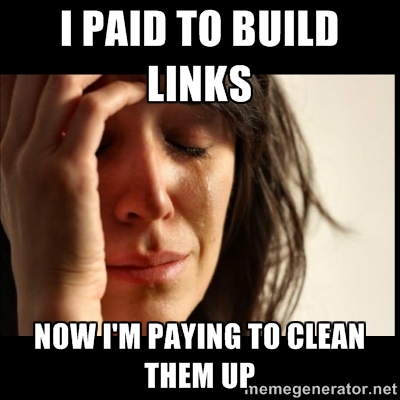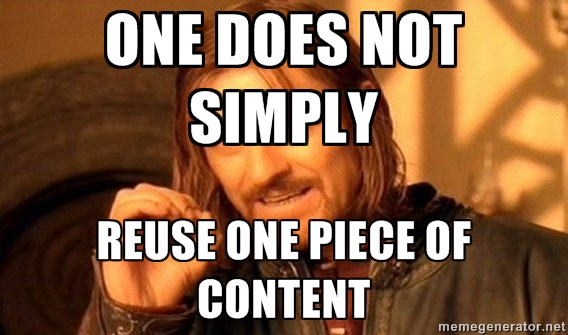Something that I love about SEO is that it is in an ever changing discipline. What worked for you last year may not work at all for you now, or in the near future. This is something that is often a bone of contention, causing disputes within the SEO fraternity, and further afield. However, this ‘ever-changing’ nature can lead to areas of confusion (and out-and-out dispute) with which tactics are the right ones.
This is completely understandable, but my recent experiences have frustrated me. If fact, they’ve pissed me off. While reviewing the incredibly poor work of a fairly well known UK agencies SEO work (I will not disclose which agency, however I can assure you that it is not Verve Search) and well as a somewhat off-putting remark from a web developer has forced me to set the record straight. In this post I share some essential do’s and don’t’s for SEO today.
The Problem
The problem that I’ve recognised recently (and that I have a particular problem with) is that the fast changes in the SEO field causes a confusion with related disciplines, such as:
- Web developers
- PPC consultants
- PR firms
- Online marketing consultants
- Not to mention a large amount of senior decision makers…
These all struggle to understand what’s ‘in’ and what’s ‘out’ with SEO. This is just part of a contributing factor to many so-called ‘internet marketers’ claiming that SEO is dead *yawn*. Not to mention a very popular UK newspaper publishing an article on this very matter recently (no, I am not linking to it). For all those naysayers, I’ll just direct them to the brilliant recent post by Martin Macdonald. Is SEO dead? No, it’s not. Are you up-to-date on SEO? Not necessarily…
I recently experienced this first hand, when a web developer I was working with tried to inform me that he thought
“…using an XML sitemap was ‘old school’ SEO”
I of course profusely told him otherwise… The reason that I am writing this post is to, at least for now, put that and a number of other areas of confusion to bed. So through a collection of witty innuendoes, terrible SEO memes and a dash of some genuine insight, here goes…
SEO in 2013: Do’s:
Technical SEO
Google (and other search engines) have increasingly sounded out their intention to serve the best possible user experience to their users. This doesn’t mean just quick loading times (although this is now widely viewed as a ranking factor) but also a technically-healthy website. The field of ‘technical SEO’ has developed a lot over the last few years, and for good reason too. A purely technical focus for some SEOs, particularly when working on large fast-moving sites, like eCommerce or news sites, can provide far greater return on investment than a team of ‘outreach’, or ‘linkbuilding’ specialists will. Getting the technical aspects of SEO right, should be a first step to most SEO strategies.
Knowing your differences between:
- 302 and a 301 redirects – and their importance in transferring link authority
- The importance of adding an XML sitemap to your site
- Removing the infamous disallow: / from your robots.txt file
- Or how best to handle pagination issues for SEO (and the implications of your decisions)
Should be considered absolute basics. There are many, many examples of technical SEO, however getting your site set up the best possible way for search engine crawlers will only benefit you in the future. Technical SEO is very worthwhile the investment of time and resource.
Content-Based Approach to SEO
The days of article spinning, link farms, and low-quality content are long gone. If you are still doing this, stop. If you are, and believe that you’re ‘beating the system’, you’re not. If you are selling this as a service, you’re an asshole (at least in my book). If you do not have a focus on the production of high-quality content, and a robust content strategy to support your SEO efforts. You will fail eventually.
Now don’t get me wrong on this, I actually believe that there are many genuine cases where investment in content is just too damn pricey to invest in for small (and even large) businesses. Being able to say no is not a bad thing. However, whether running your own shop, or working in an agency, you should be attributing value to your content creation efforts, and calculating an ROI, to prove it’s worth. If you’re not, then start asking questions.
The fact remains, that humans like good content. And when people like content, they share content, they start discussions about good content, and they link to good content. In essence, they do the leg work for you. It’s not easy, but crack this and you will please your client, and possibly increase your retainers or share of budget.
SEO in 2013: Don’t Do’s
Link Spam
Very closely tied to the need for having a content-based approach to SEO, and trust me when I say this… If you are building links through spammy (what Google calls ‘unnatural’) practices, you will suffer the consequences. Many SEOs have been saying this for 2+ years now, but some just don’t seem to understand, link spamming is gaming Google’s algorithm, and they don’t like that. They will hunt you down and slap a penalty so big on your site that you won’t even remember your own name.
There is a reason that a number of fantastic link cleanup tools have come on to the market, such as: LinkRisk (personal favourite), Link Detox, Remove ’em, Rmoov, SEOgadget’s Cleanup & Contact tool and even Google’s own Disavow tool. There is a market now for cleaning up dirty, spammy link profiles, so much so that people have built tools and are selling this as a service.
Duplicate Content
It’s old news to many SEOs worth their salt now, but since early 2011 (Panda update) duplicate content has been a big no no. This has changed a number of old school (read: crappy) SEO tactics like: spinning content, article submissions, advertorial abuse and more recently over-optimisation of press releases. There is one thing that I believe most short-sighted or under experienced digital marketers seem to overlook time and time again:
“Our advice for publishers continues to be to focus on delivering the best possible user experience on your websites and not to focus too much on what they think are Google’s current ranking algorithms or signals” (Source: Google Webmaster Blog)
If you are someone who is struggling to get over why the apparent overuse of the same (or very similar) content blur your vision, I implore you to read that sentence carefully. Now read it again, this time with your head removed from your arse.
Google, nor any other search engine for that matter, don’t want users searching for a term and being presented with 10 [7] links to the same content across several sites. The Panda update was geared towards changing this, and it makes absolute sense. Now deal with it.
Ignore Other Media Types
Segwaying nicely from the previous point: stop relying on simply text-based content for SEO. Much like the publishing (and online publishing) industry, the web has come on leaps and bounds from simply providing dull, lifeless text-based content. Those that are seriously making inroads into ranking for search terms are utilising more engaging mediums and content types, such as:
- Images
- Video
- Podcasts
You can optimise these for search too. So create this content and create something that provides value for the user.
People are inherently lazy. The web only serves to amplify this further. The increase in broadband penetration and 3G [4G] speeds mean that users are far more likely to engage with richer content types. These should be helping to form an increasing proportion of your SEO and content strategy.
Try including high quality product imagery, video demonstrations or tutorials, or podcasts to support your SEO efforts. Not only will including (and optimising!) these assets give you visibility in universal search, but you’re likely to see a boost in engagement and conversion rates too. This helps to achieve harmony in you online marketing efforts. This enables you to talk to a wider audience, gets you working closer with your content team and provide results that far outreach your boring text summaries.
SEO in 2013: A Call To Arms
As SEOs it is our duty to provide our clients, or the companies that we work for, with up-to-date tactics based on campaigns that will capitalise upon the changes that the search engines have put in place. Many remain in the dark and offer poor insights into what can be achieved through creative thinking and great technically-minded execution. We must educate those that we work closely alongside to ensure that they are not thinking about old, ineffective tactics for their campaigns. Ensuring that they remain up-to-date and work synergistically to achieving the overall goal. Greater visibility, greater gains = happy companies.
I love feedback on all of my articles, and seeming as this article was produced (almost therapeutically) out of personal dissatisfaction of work that I have seen so-called ‘SEO specialists’ providing, I’d love to hear if you agree/disagree on my points above. Or, if you have any tactics that you’ve come across that you simply want to bitch about too…
Update:
While I will not disclose the agency in question in this article, I can assure you that it is not Verve Search. I have the utmost respect for Lisa Myers and her team, they produce great content and would have absolutely no hesitation to recommend them heartily.













